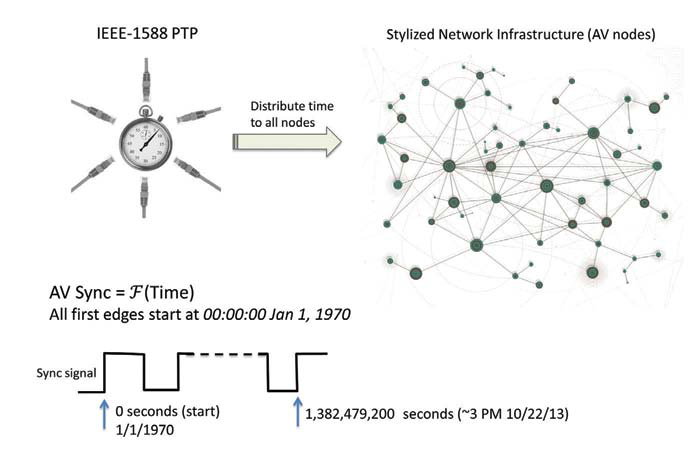SMPTE Looks at All-IT Media Facilities

Al Kovalick
At SMPTE’s Annual Technical Conference in Hollywood in late October, I had the privilege of chairing the session “The Move to the all-IT Media Facility.” Over the years, the conference has focused primarily on AV topics, but the tide is changing and SMPTE is now taking a leadership role to educate our industry in AV and IT topics. The session had nine papers/presentations.
The topics of this column are normally cloud-focused, however, this article will review several of the conference papers and their value in the IT media facility. Over time, the local media facility and cloud will co-exist with files and streams flowing between them. So, what applies to the local media facility applies to the cloud as well.
TIME AND SYNCHRONIZATION
The first two papers, presented by Paul Briscoe from Harris Broadcast and Nikolaus Kero of Oregano Systems, discussed implementing precise time and synchronization using the Precision Time Protocol (PTP IEEE-1588v2). Basically, using IP networks, it is possible to transfer time from a master clock node to a slave clock node. The master clock is usually tied to GPS time, but slave nodes (AV gear in a facility or venue) can lock their local clock within 5 seconds to 100 ns of the master under heavy network load.
The slave clock can be used to compute any periodic video or audio sync signals as typically provided by the so-called reference black signal. SMPTE is in the process of standardizing usage of IEEE-1588 for facility sync use.

Fig. 1: Facility time and synchronization using IEEE-1588 Precision Time Protocol
Fig. 1 demonstrates a periodic sync signal starting at 1/1/1970 and computed using local nodal time. If we know the elapsed time since 1/1/1970, we can compute the state of any periodic signal now. If all nodes do this then all equipment I/O signals are sync aligned. These methods are an improvement compared to routing special, non-IT-friendly, “burst” signals to all nodes.
LOW-LATENCY TRANSFER
A third paper from Thomas Kernen with Cisco and Steve Posick from ESPN, discussed low-latency media transfer in a facility over IP networks. Years ago, the delay through an IP switch was measured in milliseconds; today, switches under full load can have a passthrough delay of 1–2 μsec. This is a fraction of an HD video line.
It’s not hard to imagine an IP or MAC layer switch replacing an SDI router with equivalent functionality including VBI frame-accurate signal switching and loss-less connectivity. The authors discussed the evils of using large buffers inside switches in an attempt to smooth out network traffic. Some buffering is needed; too much can create bursts of traffic and increase packet loss in big systems.
There is work underfoot to define best practices for AV switching in a facility. This effort is undertaken by the Joint Task Force for Networked Media (see tinyurl.com/lj2sm9j).
HYBRID ARCHITECTURES AND SOFTWARE-DEFINED NETWORKS
The fourth presentation from Eric Pohl with National TeleConsultants, reflected on several themes:
• Problems using SDI to transport 2K and UHDTV rate (~4K) signals. Hence the need to leverage Ethernet’s 10G and 40G links;
• Increased reliance on IT storage and servers for workflows, and
• Huge increase in “any format to any platform” translation.
Pohl pointed out that future architectures will be hybrid in nature; that is, IP transport will co-exist with SDI. Only green-field sites could be all IT. Of course, this assumes that IT/Ethernet meets all workflow needs which is not true today.
Presentation five, “Software Defined Networks for Media Workflows” from Ammar Latif of Cisco, showed the advantages of using programmable SDN methods to configure media networks. We require predictable large, constant bandwidths, loss-less connectivity and scale across many hundreds of nodes. SDN shows promises to program the network for the QoS needed per workflow.
The author outlined the basics of SDN, showing how external controllers can update a router’s configuration for new workflows. As we move to more automated and orchestrated workflows, SDN may well find a home in the media facility.
TECHNICAL TRENDS TO LEVERAGE
Paper six, “The Foundations of the all-IT Media Facility” also was from this author. It started by defining six undeniable technical trends that we must leverage. These are: 1) Ethernet and its ecosystem; 2) Moore’s Law; 3) storage capacity growth averaging 40 percent per year since 1956; 4) Metcalfe’s Law; 5) cloud leverage; and 6) the move to Web apps (SaaS model).
These important trends are factored into what the future media facility could look like:
• Ubiquitous use of servers, storage and networks; AV at the edges
• File and stream transport over lossless and deterministic IP/MAC layer networks
• IEEE-1588 time and sync for all nodes
• Automated workflows with strict QoS
• Cloud integration
In the seventh presentation, Matt Klein with Xilinx explained that many common 2D/3D video manipulations (transform, composite, switch, generate, etc.) can be performed using high-performance FPGA “system-on-a-chip” methods. These modules integrate with IP networks to augment servers towards a complete media processing set of services.
With the potential advent of 4K data rates, servers will need hardware accelerators to enable full-featured workflows. So-called “glue products” may be consolidated into a single programmable unit devoted to all manner of transforms. Add these, like Lego blocks, to create workflow services.
SWITCHING CHALLENGES
Presentation eight, from Thomas Edwards with Fox and Andy Bechtolsheim from Arista Networks, discussed the challenges in switching video frames accurately, as with SDI routing, using Ethernet. They proposed using an Arista switch with internal FPGA modules programmed to identify the VBI location for switching. So, the switch could be made video aware. Andy added some clout to the program; he is a cofounder of Sun Microsystems and Chairman of Arista.
On the ninth paper, Luc Andries from SDNsquare described architecture for deterministic file and stream IP transport based on IEEE standards coupled with SDN methods. Luc showed simulations of fully loaded media networks working at near capacity with no packet loss. There was much to appreciate about this talk.
In the end, the conference provided food for thought and substantial support for the all-IT facility being a near-future reality.
Al Kovalick is the founder of Media Systems consulting in Silicon Valley. He is the author of “Video Systems in an IT Environment (2nd ed).” He is a frequent speaker at industry events and a SMPTE Fellow. For a complete bio and contact information, visitwww.theAVITbook.com.
Get the TV Tech Newsletter
The professional video industry's #1 source for news, trends and product and tech information. Sign up below.

